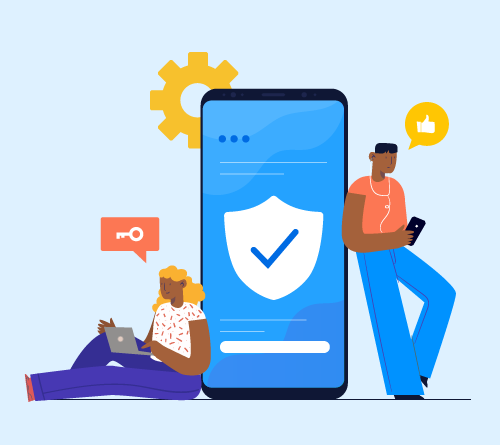Things to Consider on App Protection From The View Of Developers
App protection is one of the most important things you can do as a developer. If your app is not protected, it could be removed from the App Store and make your job much more difficult. Here are some things to think about when designing an app protection strategy for developers:
What Developers Look for in an App
Developers are always looking for ways to improve their productivity and make their workflow more efficient. App protection is one of the most important things they look for when vetting an app. In this blog, we’ll discuss what developers consider regarding app protection and which features are essential for a good security posture.
When evaluating an app, developers want to know that their data is safe and secure. The first step in securing an app is ensuring it’s not vulnerable to attack. A good way to do this is using a security scanner like AppScanner, which can identify common security issues such as weak passwords, insecure permissions, and outdated software.
Another important factor in protecting an app is confidentiality. Apps that store or transmit confidential information should encrypt this data using a strong algorithm such as AES-256. Additionally, apps should employ secure communication protocols such as SSL/TLS to protect user data from interception.
Last but not least, developers consider the overall security posture of the app when deciding on whether or not to invest time and resources into protecting it. Security features essential for a good app protection posture include multi-factor authentication, firewalls, intrusion detection/prevention systems, and data encryption.
How Developers View App Security?
As the industry for mobile app development continues to grow, so does the need for app developers to take steps to protect their apps from malicious attacks. Here are a few things to consider when protecting your apps:
- Security protocols should be in place from the development stage. This includes using secure coding practices and developing robust security testing processes.
- Make sure all user data is properly protected at all times. This includes encrypting sensitive data and storing it in a secure location.
- Ensure that app functionality is not accessible outside of the app itself. This includes implementing appropriate security measures on third-party APIs and integrations.
- Regularly review app security measures to ensure they are up to date and effective.
Developers should remember that app security is a continuous process and should always be vigilant in looking for potential threats. By taking these simple steps, developers can help ensure the safety of their apps and customers.
How to Ensure App Security?
One of the most important aspects of ensuring app security is to create a secure development environment for your apps. Here are some tips that will help you:
- Use a robust security layer such as SSL/TLS when connecting to the internet.
- Ensure your code is well written and error-free.
- Create strong user identities and passwords.
- Keep track of updates and install them promptly.
- Monitor activity on servers and devices used in your app.
What are App Protection and App Encryption?
When you develop an app, one of the most important things to consider is how to protect the app from being pirated or stolen. This is especially important for new developers, as it’s easier for someone to copy and distribute an unauthorized version of your app than it is for them to create a new one from scratch.
One way to protect your app is through App Protection. App Protection is a feature that allows you to restrict which devices and iOS versions your app can be installed on. You can also use App Encryption to ensure that your data remains confidential in transit or storage.
App Protection Options
When it comes to app protection, developers need to consider several things. Here are some tips to help them make the right decision for their app:
- Use a security solution that is tailored specifically for your app. This will help you avoid common issues and protect against new attacks.
- Ensure all user data is encrypted before storing it on the device or server. This prevents unauthorized access and theft of data.
- Use push notifications sparingly and only when necessary. Push notifications can enable attackers to access an app without being noticed.
- Always keep up with the latest app protection technologies. By doing so, you can ensure your app remains safe and secure.
- Educate your users about the importance of app security. By doing so, you can ensure that their data is protected and that they are aware of potential threats.
How Developers Can Protect Their Apps?
Developers need to protect their apps from a variety of attacks. This includes preventing direct access to sensitive data and protecting against malware. Here are some things to consider when app protection:
App security starts with creating strong passwords and authenticating users before granting access. Make sure your users know how to sign in, and don’t give them easy access to devices or accounts they shouldn’t have access to.
Enable two-factor authentication for additional security. This adds an extra layer of protection by requiring users to enter both a password and a code sent via text or an app.
Secure data with encryption and password protections. Make sure all data is protected with strong encryption, including user passwords. Store encrypted data on secured servers and don’t store personal information such as credit card numbers or social security numbers in your app.
Keep track of user activity and logs for analysis. Track who is accessing your app, what they’re doing, and when. This information can help you identify unauthorized activity and determine whether any malicious software is being installed on users’ devices.
Install antivirus software on all authorized devices and keep it up-to-date. Antivirus software can help detect malicious software before it can damage your app or data.
Use security features offered by the Appsealing app developer and platform services, such as two-factor authentication and encryption.
Developers can also protect their apps by following these best practices:
Make sure your app is installed on authorized devices. Users should only be able to access your app if it is installed on their device.
Ensure that users are authenticated before granting access to sensitive data. Authentication allows you to ensure that users are who they say they are and prevents unauthorized access to your app’s data.
Store encrypted data on secured servers. Protect user passwords with strong encryption, and don’t store your app’s personal information such as credit card numbers or social security numbers.
Keep track of user activity and logs for analysis. Track who is accessing your app, what they’re doing, and when. This information can help you identify unauthorized activity and determine whether any malicious software is being installed on users’ devices.
Conclusion
Developers are the lifeblood of any app-based business. Without them, there would be very few apps worldwide and no one to profit from them. However, protecting their apps is just as important to developers as businesses of all sizes.



